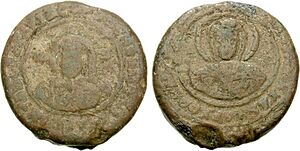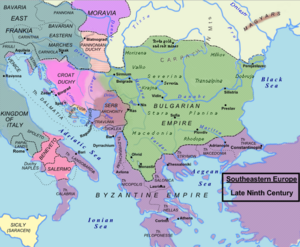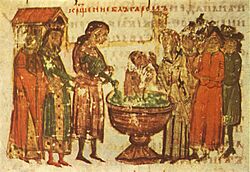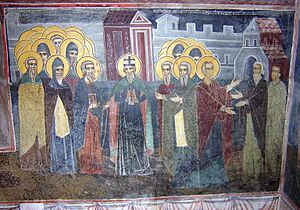Boris I of Bulgaria facts for kids
Quick facts for kids Boris I |
|
|---|---|
| Knyaz of Bulgaria | |

Saint-Knyaz Boris I, Equal-to-the-Apostles
|
|
| Reign | 852–889 |
| Predecessor | Presian |
| Successor | Vladimir |
| Died | 2 May 907 A monastery near Preslav |
| Spouse | Maria |
| Issue | Vladimir Gavrail Simeon I Evpraksiya Anna |
| House | Krum's dynasty |
| Father | Presian |
| Religion | Chalcedonian Christianity |
| Saint Boris | |
|---|---|
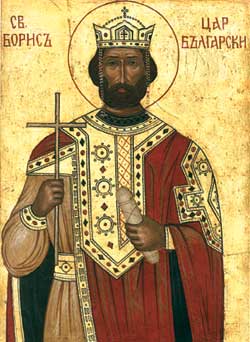 |
|
| Equal to the Apostles | |
| Born | 827 |
| Died | 907 |
| Venerated in | Eastern Orthodoxy |
| Canonized |
|
| Feast | 2 May |
| Patronage | Bulgarian people |
Boris I (also known as Bogoris), was a very important ruler of the First Bulgarian Empire. He ruled from 852 to 889. People also call him Saint Boris I (Mihail) the Baptizer. He died on May 2, 907.
Even though he faced some military challenges, Boris I's time as ruler was full of big changes. These changes shaped the history of both Bulgaria and Europe. In 864, he made Christianity the official religion of Bulgaria. This meant that the old pagan beliefs were no longer followed.
Boris I was also a smart diplomat. He used the disagreements between the Church in Constantinople and the Pope in Rome to his advantage. He managed to get an independent Bulgarian Church. This helped calm down the nobles who were worried about the Byzantine Empire interfering in Bulgaria.
In 885, some important teachers, the disciples of Saints Cyril and Methodius, were forced to leave Great Moravia. Boris I welcomed them into Bulgaria. He helped them save the Glagolithic alphabet and later encouraged the growth of the Cyrillic script in Preslav. This also helped Slavic literature grow.
After he stepped down from power in 889, his oldest son tried to bring back the old pagan religion. But Boris I came out of retirement and removed him from power. After this, a big meeting called the Council of Preslav took place. During this meeting, Bulgarian priests replaced the Byzantine ones. Also, the Greek language was replaced with what is now called Old Church Slavonic.
Today, Boris I is seen as a saint in the Eastern Orthodox Church. He is known as the Prince who brought Christianity to Bulgaria. He is also called "Equal-to-the-Apostles". His special day is celebrated on May 2.
Contents
What's in a Name? Boris's Titles
The name Boris probably comes from the old Bulgar language. After he officially became a Christian, Boris took the Christian name Michael. Because of this, some historians call him Boris-Michael.
We know about Boris's title from his official seals and an old writing found near the town of Ballsh in modern Albania. Another writing was found in Varna. In these writings, he is called "Archon of Bulgaria." This title usually means "ruler." Later, in the 10th and 11th centuries, he was also called "Knyaz" (Кнѧзъ). In Bulgarian writings from his time, Boris I is called "Knyaz." During the Second Bulgarian Empire, he was called "Tsar."
Today, historians use different titles for Boris. Most agree that he changed his title after becoming Christian. They believe he was called "Khan" or "Kanasubigi" before his baptism. After that, he became "Knyaz."
Boris I's Rule: Important Events
Military Challenges and Victories
Boris I became ruler after his father, Presian I. In 852, he sent messengers to Eastern Francia to confirm a peace treaty. At first, he threatened to invade the Byzantines, but his armies did not attack. He gained a small area in Strandzha to the southeast.
In 854, the Moravian Prince Rastislav asked Boris I for help against East Francia. Some people say that Franks paid Boris to attack Louis the German. But this campaign was not successful for Bulgaria. Louis won a big victory and invaded Bulgaria.
At the same time, the Croats started a war against the Bulgarians. Before this, the two peoples had lived peacefully. This suggests that Louis might have paid the Croats to attack Bulgaria. This would distract Boris from his alliance with Great Moravia. Boris could not win, so both sides made peace.
In 855–856, a conflict began between the Byzantines and Bulgarians. Boris was busy with his fight against Louis. Because of this, he lost the city of Philippopolis (Plovdiv), the region of Zagora, and ports on the Black Sea. The Byzantine army led by Michael III took these areas.
Conflicts with Serbia
After the death of Prince Vlastimir of Serbia around 850, his state was divided among his sons. Vlastimir and Boris's father had fought before, and Serbia had won. Boris wanted to get revenge for that defeat.
In 853 or 854, the Bulgarian army, led by Boris I's son Vladimir-Rasate, invaded Serbia. Their goal was to take over from the Byzantine Empire's influence on the Serbs. The Serbian army was led by Mutimir and his two brothers. They defeated the Bulgarians and captured Vladimir and 12 important nobles.
Boris I and Mutimir agreed to make peace. Mutimir sent his sons to the border to escort the prisoners. They exchanged gifts as a sign of peace. Boris gave them "rich gifts," and in return, he received "two slaves, two falcons, two dogs, and 80 furs."
Later, there was a fight among the Serbian brothers. Mutimir sent his two younger brothers to the Bulgarian court. But Mutimir kept his nephew, Petar, at his court for political reasons. The reason for their family feud is not fully known. Petar later defeated Mutimir's son and became the ruler of Serbia.
Why Boris Became Christian
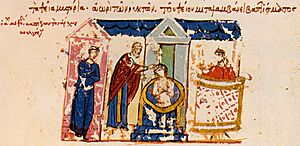
There are different ideas about why Boris decided to become Christian. Some historians think his sister, who had already become Christian in Constantinople, influenced him. Another story says a Greek slave in his court played a role. A more legendary story says Boris was scared by a picture of Judgement day and decided to become Christian. Many historians believe his decision was smart and practical for his country.
Boris was interested in becoming Christian for several reasons. He wanted to expand his power over the Slavic world. He also wanted an ally against the Byzantine Empire, a powerful enemy. So, Boris tried to make an alliance with Louis the German against Ratislav of Moravia. Through this alliance, Louis promised to send missionaries to Boris. This would have brought the Bulgarians under the Roman Church.
However, in late 863, the Byzantine Empire under Emperor Michael III declared war on Boris and the Bulgarians. This happened during a time of famine and natural disasters. Boris was caught by surprise and had to make peace with the Byzantines. He promised to convert to Christianity according to the Eastern Church's ways. In return, he got peace and some land in Thrace.
In early 864, Boris was secretly baptized in Pliska. An embassy of Byzantine priests baptized him, along with his family and some important Bulgarian nobles. Emperor Michael III was his godfather, and Boris took the Christian name Michael.
Besides diplomatic reasons, Boris wanted to convert himself and the Bulgarians to Christianity to unite his society. When he became ruler, the Bulgarians and Slavs were separate groups in his kingdom. The Bulgarians were a smaller group of military leaders. The Slavs had their own many-god belief system. The Bulgarian leaders believed in Tangra, the Sky God. Christianity helped bring these groups together.
The arrival of Methodius's followers brought the Cyrillic alphabet. This meant Bulgarians didn't have to rely on Greek for writing and church services. A Slavic Christian culture grew, which helped unite the country.
Bulgaria Becomes Christian
After his own baptism, Boris's first big task was to baptize his people. He asked Byzantine priests for help between 864 and 866. Boris also wanted to learn how to live a Christian life and how to set up an autocephalous (independent) church. He asked the Byzantine Patriarch Photios for advice.
Photios's answer was not what Boris wanted. So, Boris looked for a better deal from the Pope in Rome. In August 866, Boris sent messengers, led by the kavhan Peter, to Pope Nicholas I in Rome. They had a long list of questions. The Pope sent 106 detailed answers about religion, law, politics, customs, and faith. Boris also complained to Nicholas about problems caused by the Byzantine priests who baptized the Bulgarians.
Bulgaria's move towards the Pope made Patriarch Photios very angry. In 867, he wrote a letter to the Eastern clergy. In it, he criticized the practices of the Western Church and Rome's involvement in Bulgaria. This led to the Photian Schism, a big step in the split between the Eastern and Western Churches.
To answer Boris's questions, Pope Nicholas I sent two bishops to Bulgaria. In Bulgaria, Bishop Formosus (who later became Pope Formosus) was very successful. But the Pope refused Boris's request to make Formosus the archbishop of Bulgaria. The Pope said it was "against church rules to move an already established bishop from one church to another."
The new Pope Adrian II also refused Boris's request for a similar appointment. After this, Bulgaria started to lean towards Constantinople again. At the Fourth Council of Constantinople in 870, Bulgarian envoys brought up the issue of the Bulgarian church again. The Eastern patriarchs decided in favor of Constantinople. This decision shaped the future of the Bulgarian Orthodox Church. It was given the status of an independent archbishopric by the Patriarchate of Constantinople and its own archbishop.
Becoming Christian had a huge impact on Bulgaria. It changed not only their religious beliefs but also how the government worked. By accepting Christianity, Boris took the title of Knyaz. He joined the group of nations that followed Christ, which pleased the Eastern Roman Empire.
Towards the end of his rule, Boris started to have more Bulgarian priests. He sent Bulgarians to Constantinople to study in monasteries. Some of these Bulgarians returned home to become priests. In 885, Boris got another chance to have native clergy. This happened when the Slavic-speaking followers of St. Cyril and St. Methodius had to leave Moravia.
New Culture with Clement and Naum
In 886, Boris's governor in Belgrade welcomed the disciples of Saint Cyril and Saint Methodius. They had been forced to leave Great Moravia and came to Bulgaria. The governor sent them to Boris in Pliska. Boris was happy to meet two of these disciples, Clement of Ohrid and Naum of Preslav. They were from noble Bulgarian Slavic families. To use their talents, Boris asked Clement to be a "teacher" in the province of Kutmichevitsa.
Clement and Naum were very important in continuing the work of Cyril and Methodius. They helped develop Slavic writing and church services. They set up schools in Pliska and Ohrid. Clement later trained thousands of Slavic-speaking priests. These new priests replaced the Greek-speaking clergy from Constantinople who were still in Bulgaria. The alphabet that Cyril and Methodius first created is known as the Glagolitic alphabet.
In Bulgaria, Clement of Ohrid and Naum of Preslav created a new Bulgarian alphabet. This alphabet was later called Cyrillic. In 893, Cyrillic was declared the official alphabet. Old Bulgarian was also declared the official language in the same year. In the centuries that followed, other Slavic peoples and countries adopted this alphabet. The use of Slavic language in church services went hand-in-hand with Boris's efforts to build more churches and monasteries.
Challenges to Christian Conversion
Not everyone in Bulgaria was happy about becoming Christian. Some important Bulgarian leaders strongly opposed it. Some refused to become Christians, while others went back to their old beliefs after being baptized. They started a rebellion against Boris because he forced them to be baptized. Some people didn't necessarily object to Christianity itself. Instead, they didn't like that foreign priests brought it, which meant foreign influence.
By breaking the power of the old religions, Boris reduced the influence of the boyars (nobles). These boyars had resisted the ruler's authority. In the summer of 865, a group of Bulgarian nobles started an open revolt. Boris put down the revolt very strictly. He executed 52 boyars and their entire families. This allowed the Christianization to continue.
The End of Boris's Rule
In 889, Boris gave up his throne and became a monk. His son and successor, Vladimir, tried to bring back the old pagan religion. This made Boris come out of his retirement in 893. Boris defeated Vladimir and had him blinded. Vladimir's wife had her head shaved and was sent to a monastery.
Boris then called the Council of Preslav. He placed his third son, Tsar Simeon I of Bulgaria, on the throne. Boris warned Simeon that he would face the same fate if he also turned away from Christianity. Boris then went back to his monastery. He came out again around 895 to help Simeon fight the Magyars. The Magyars had invaded Bulgaria with the help of the Byzantines. After this crisis passed, Boris went back to his monastic life. He died in 907. We are not sure exactly where he lived as a monk or where he was buried. It might be near Preslav, or Pliska, or in a Ravna Monastery near Varna.
Boris I's Lasting Impact
St. Boris Peak on Livingston Island in Antarctica is named after Boris I of Bulgaria.
Boris I's life is shown in the 1985 film "Boris I" (Борис Първи). Stefan Danailov plays the main role in the movie.
See also
 In Spanish: Boris I de Bulgaria para niños
In Spanish: Boris I de Bulgaria para niños
- Christianization of Bulgaria
- Cyril and Methodius
- Glagolitic alphabet
Resources
- Bulgarian history – Boris I
- The Ecumenical Patriarchate of Constantinople
| Regnal titles | ||
|---|---|---|
| Preceded by Presian I as Khan |
Knyaz of Bulgaria 852–889 |
Succeeded by Vladimir |


